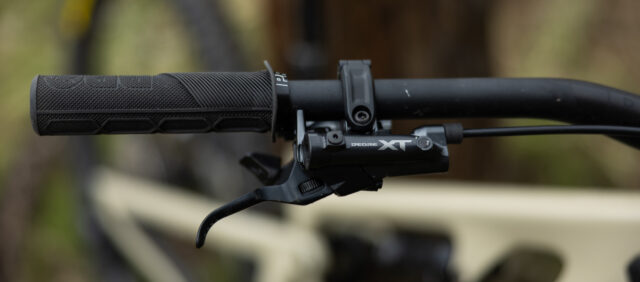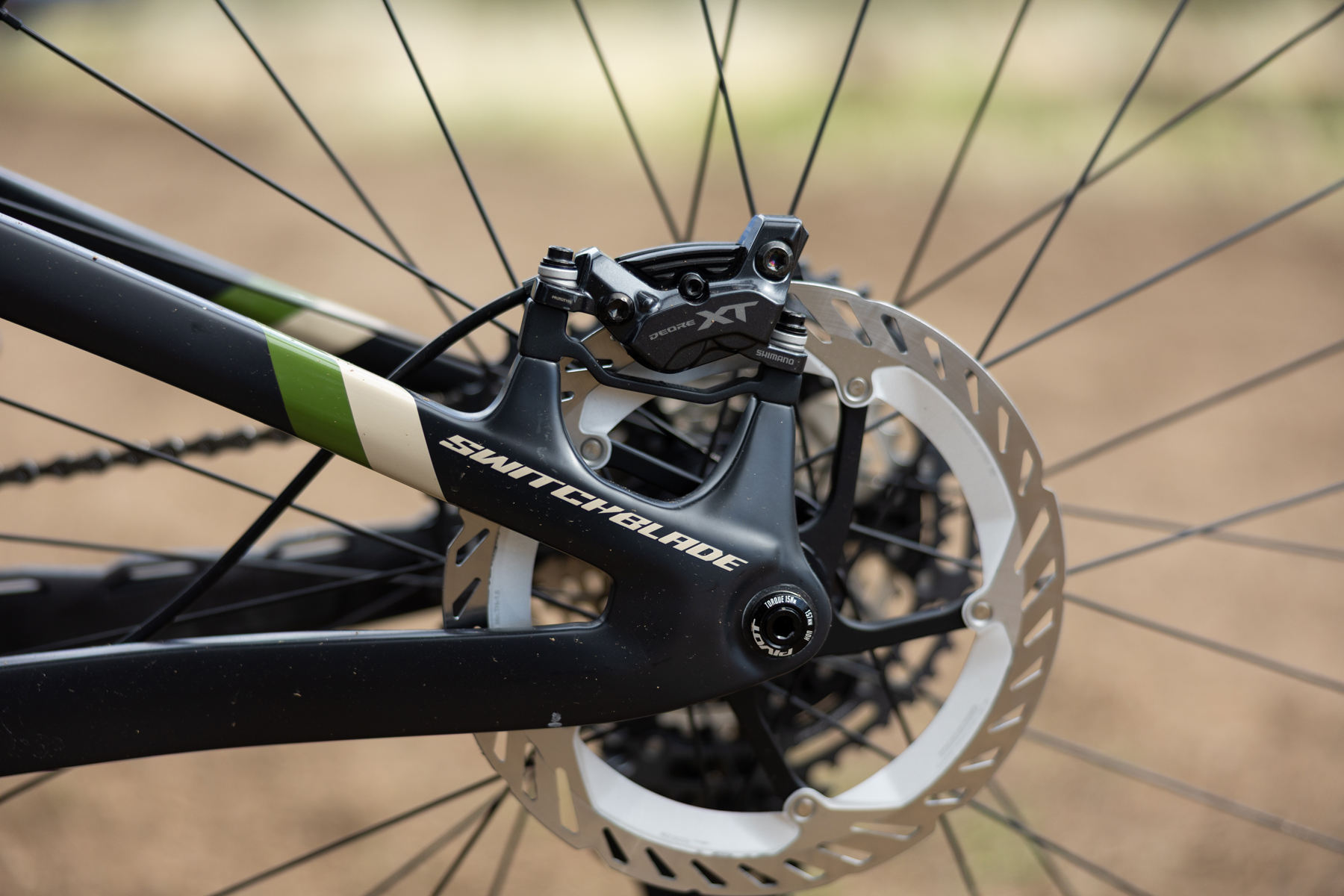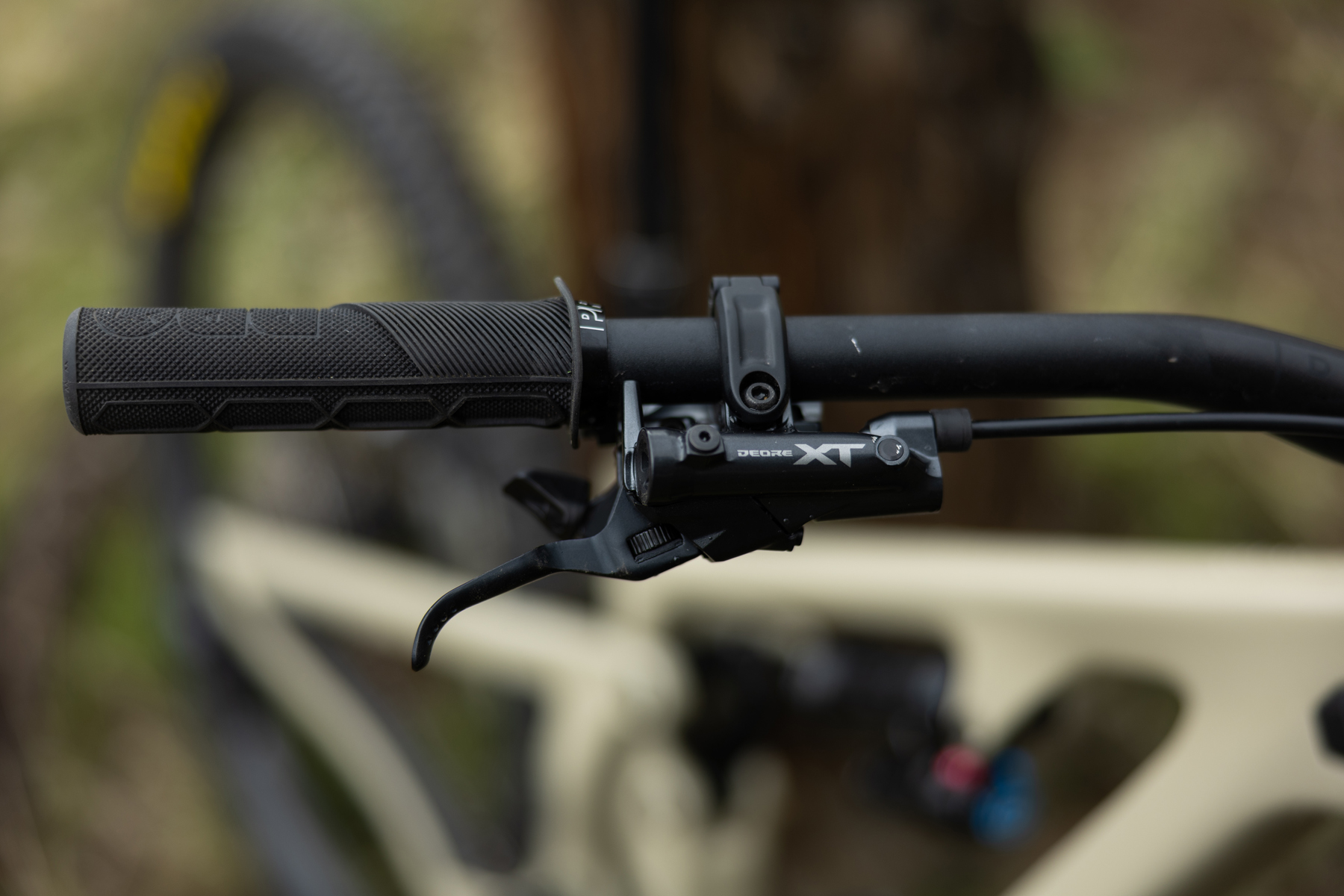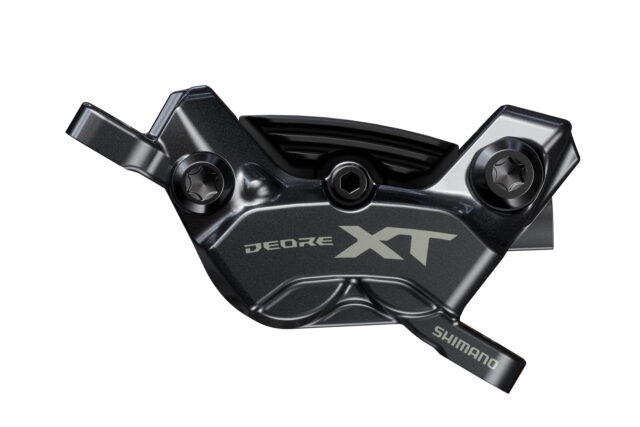Intended Use: Trail / Enduro
MSRP: $265 per brake ($530 for front & rear set)
Stated Weight: 310 g front / 330 g rear
Intended Use: XC
MSRP: $240 per brake ($480 for front & rear set)
Stated Weight: 287 g (front) / 321 g (rear)

Intro
Shimano’s MTB division has been busy, having debuted their first wireless MTB drivetrain just a couple of weeks ago in the form of the top-tier XTR groupset. Now, they’re following up with more affordable Deore and XT versions very shortly thereafter.
They also launched new XTR brakes to go with the new drivetrain, and are following suit with new XT stoppers as well. The Deore brakes don’t get a corresponding update, but there’s still a lot to cover here with the revised XT brakes, so let’s get to it.
Design & Features
The new XT brakes are still offered in two- and four-piston versions, and the updates closely mirror those Shimano made to the new XTR M9200 and M9220 brakes. Since so many of the design considerations and updates are shared between the two tiers, we’ll quote from our review of the new XTR brakes:
Improving the consistency of the brakes was Shimano’s top goal for the new versions. Shimano’s higher-end brakes have long suffered from wandering bite points (which we’ve covered quite extensively), and Shimano says that those problems are resolved with the new brakes.
They’ve taken several steps to get there. The prior-generation brakes use ceramic pistons because their low thermal conductivity minimizes heat transfer from the brake pads to the fluid. The new-generation brakes have switched to resin pistons, which Shimano admits aren’t as thermally insulating as the ceramic ones of old. However, Shimano says that they’re able to achieve a much smoother, more consistent surface finish on the resin pistons, which makes for more robust sealing at the pistons.
The new brakes still use mineral oil, but Shimano has come up with a new, lower-viscosity formulation for them. The combination of the new oil formulation and new piston material also allowed Shimano to change the material they use for all the internal seals in the brakes, again to improve sealing and with it, the consistency of the brakes. The new piston seal material is also said to rebound more consistently across a wider temperature range.
Shimano is exceedingly clear that the new low-viscosity oil should not be used in any of their prior-generation brakes. They say that ignoring this instruction will lead to full brake failure — you need the new pistons and seals for the low-viscosity oil to work properly.
Thankfully, the new brakes use the same bleed kit as the outgoing ones, and Shimano says that you don’t need to worry about slight cross-contamination of the two oil types in the bleed tools, but you should not mix and match any further than that.
All those updates carry over to the new XT brakes and make up the biggest changes, but some finer details set them apart from the XTR versions. So let’s dive into those and the two different versions of XT brakes on offer.

XT M8220 Four-Piston Brakes
- MSRP: $265 per brake
- Stated Weight: 310 g (front) / 330 g (rear)

As with the new XTR brakes, the four-piston XT ones get a more complete overhaul than the two-piston variants. The four-piston brakes are also unquestionably the more popular option of the two, so we’ll start there. Once again, the changes are quite similar to the XTR updates, so we’ll quote from that review again:
Shimano has overhauled the lever and caliper of the new four-piston brakes, in addition to the previously mentioned updated pistons / seals / fluid. Let’s start at the lever end:
The new lever still gets a tool-free reach adjuster and a tooled contact point adjuster, though the reach adjuster is now packaged more cleanly into the lever blade, rather than protruding forward of it.
The lever clamp design is unchanged, with a hinged clamp secured by a single bolt, and a push-button release to open the clamp as a failsafe if the bolt comes loose. Shimano has also left their I-Spec EV integrated clamp design unchanged — a welcome decision, since they’ve gone through a number of iterations of I-Spec clamps over the years.
The new brake lever still uses a ServoWave cam to vary the brake’s leverage throughout the stroke, but the cam profile has been tweaked to smooth out the power delivery.
The most visually obvious change is that the hose now exits the lever parallel to the bar, and much closer to it than the outgoing one. Shimano says this decision was driven by improving aesthetics for external hose routing first, though it’s also tidier with headset routing as a byproduct.
The new lever also uses a pull-style master cylinder arrangement, instead of the push-style version on the prior-generation brakes (and most others). That change was made for packaging reasons, allowing Shimano to position the lever pivot closer to the handlebar. This lets the tip of the lever blade move outward through the entire lever stroke, rather than starting to arc back inward by the bite point. The new lever blade is now swept upward by five degrees, which Shimano says helps it follow the arc your finger naturally takes as you squeeze the lever.
The overall form factor and design language of the new XT lever are essentially the same as the XTR lever; things differ a bit more at the caliper end.

The XT M8220 four-piston caliper has been updated, though it’s not quite as dramatic a change as what Shimano did with the XTR M9220. Unlike the XTR caliper, which moved from two-piece construction to a one-piece design, the XT four-piston caliper sticks with a two-piece bolted construction. The two-piece design is almost certainly cheaper to produce than the one-piece construction of the XTR caliper (simpler forgings, easier post-forging machining to clean up the areas that need it, and a few other details). The two-piece design is likely a bit heavier and maybe not quite as stiff.
The caliper design is a new one, though. And, two-piece construction aside, it gets the same updates as the XTR version. In addition to the new pistons and seals, the XT M8220 caliper gets a revised bleed port design to help make the bleed process tidier, and some tweaks to help prevent the brake-pad rattle that many folks have experienced on Shimano’s four-piston brakes for a while now. Those updates are shared with the new XTR caliper, so we’ll dip back to that review:
The new four-piston caliper also gets the updated bleed-port design that Shimano has been using on their drop-bar brakes for a while now. The new design still uses a push-on hose fitting at the caliper end, but the fitting is opened and closed by a separate 4 mm Allen key on the back of the caliper; this is meant to help avoid accidentally disconnecting the hose when opening and closing the fitting.
Shimano has also attempted to mitigate the issues with rattling brake pads that a lot of folks have noticed with their current brakes. The pad shape hasn’t changed from a compatibility standpoint, but Shimano has made the new pads fractionally longer front to back so that there’s less room for them to move around inside the caliper.
They’ve also made the hole for the pad-fixing pin oblong so that the sides of the pads will contact the caliper before the inside of that hole contacts the pin. Shimano’s internal testing revealed that contact between the pin and the pads was a bigger source of noise than pad / caliper contact, and the new pads are designed to address that. They’re also backward compatible with Shimano’s other Mx120 brakes.
XT M8200 Two-Piston Brakes
- MSRP: $240 per brake
- Stated Weight: 287 g (front) / 321 g (rear)

Like the two-piston XTR brakes, the two-piston XT stoppers keep the same caliper body as the prior-generation version, with the new pistons, seals, and fluid being the only differences at that end.
As with the four-piston XT M8220 caliper, the two-piston version’s caliper is a two-piece design; the standard M8200 caliper uses conventional post-mount tabs, though there’s an MT805 flat-mount version as well.
Unlike the XTR brakes, though, Shimano doesn’t offer a lighter, non-ServoWave version of the XT brake lever — that applies to both the prior-generation XT M8100 version and the new M8200 one.
Instead, the new XT M8200 brakes use the same lever as the M8220 four-piston ones. This combination is similar to the new M9220 lever / M9200 caliper combo offered on the XTR brakes. Shimano says the bigger ServoWave lever produces more power than the pared-down XTR M9200 one, at the expense of some weight (i.e., if you’re looking for the lightest setup, XTR is the way to go).
[Check out our Full Review of the new XTR brakes for more on that.]

Some Questions / Things We’re Curious About
(1) First and foremost, has Shimano really fixed the inconsistency issues that have plagued many of their brakes (XT included) for a while now? All indications are good from our time on the new four-piston XTR brakes, but we’ve only ridden one pair so far, and are eager to see if it holds across a bigger sample size.
(2) The four-piston XT M8220 brakes seem like they should offer very similar performance to the XTR M9220 ones on paper, but do they? What do you gain / lose by going with one or the other?
Bottom Line (For Now)
Shimano’s longstanding issues with inconsistency on their higher-end MTB brakes have put a lot of folks off them, most of our reviewers included, so it’s welcome news that they’re trying to address those problems.
Our experience with the new XTR M9220 brakes indicates that they’ve done it, so we’re keen to see if that applies to the revised XT versions as well. We’ve got the whole new XT group on the way for review, and will get time on a bunch more pairs via review bikes soon, so stay tuned to see how things go.
Flash Review: Our Initial On-Trail Impressions
BLISTER+ members and those who purchase our Digital Access Pass can check out the Flash Review below to read our initial on-trail impressions. Get our Digital Access Pass to view all our Flash Reviews and Deep Dives, or become a BLISTER+ member today to get access to that and a LOT more, including the best worldwide Outdoor Injury Insurance, exclusive deals and discounts on skis, personalized gear recommendations from us, and much more.

Flash Review: Shimano XT M8200 Di2 Drivetrain and Brakes
Update 8.12.25: We’ve started spending time on the 9-45 tooth cassette version of the new Shimano XT Di2 Drivetrain, and have some thoughts on how it stacks up against the standard 10-51 tooth version.
Blister’s Flash Reviews and Deep Dives are accessible to those who purchase one of our paid subscriptions
To get our comprehensive Deep Dives and our initial, unfiltered reports on new gear, become a member and receive many other services, deals, and discounts.
If you’re already an active member, please log in.
(If you’re already logged in and a member in good standing and seeing this message in error, please refresh this page in your browser.)
